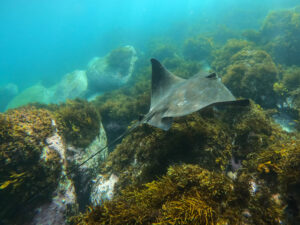Embodying a distinct blend of grace and biological marvel, the Southern Eagle Ray is a gem of Australia’s coastal waters. Distinguished by its diamond-shaped body and long, whip-like tail, the Southern Eagle Ray captivates both marine biologists and snorkelling enthusiasts alike. Let’s dive into the unique characteristics, behaviour, distribution, and conservation status of the Southern Eagle Ray. I will also offer some advice for those fortunate enough to encounter these majestic creatures while snorkelling in their natural habitat.
Identifying the Southern Eagle Ray
For those embarking on snorkelling adventures in Australia, identifying the Southern Eagle Ray in the wild becomes an enthralling quest. Sporting a distinctive diamond-shaped body, these rays possess a dorsal colouration ranging from grey-brown to olive, often with small white or pale spots. These allows them to blend seamlessly with their seafloor environment. Their underbelly is typically white, and they bear two small dorsal fins near their long, slender tail. Mature rays can reach up to 1.2 meters in disc width – a truly impressive sight for any observer!
Distribution and Conservation Status
The Southern Eagle Ray frequents the coastal waters of Southern Australia and Tasmania, extending west to Western Australia and north along the continent’s east coast. They prefer shallow waters and can often be seen foraging along sandy or muddy bottoms, near reefs, or in estuaries.
Currently, the conservation status of the Southern Eagle Ray is listed as ‘Least Concern’ by the International Union for Conservation of Nature (IUCN). However, they do face threats from habitat degradation and incidental capture in commercial fisheries. Conservation efforts are therefore essential in preserving these fascinating creatures and their habitats.
Behaviour and Character
Southern Eagle Rays are generally solitary animals, but they occasionally form loose aggregations. They are bottom-dwellers, foraging for small fish, crustaceans, and molluscs in the sand or mud using their snouts. Notably, the Southern Eagle Ray exhibits a unique escape behaviour when threatened, often leaping out of the water in an awe-inspiring display of natural agility and power.
Snorkelling with the Southern Eagle Ray
Snorkelling with the Southern Eagle Ray is an unforgettable experience. Remember, these are wild creatures, and it’s essential to respect their space. Avoid touching or chasing them, and always maintain a safe distance. Observing them calmly from afar allows for a much more meaningful interaction and minimizes disturbance to their natural behaviours.
Lastly, it’s worth noting that the Southern Eagle Ray, possesses a tail spine that can deliver a painful sting. Although they are generally docile and pose little threat to humans, it’s always wise to treat them with the caution they deserve.
In conclusion, the Southern Eagle Ray is a treasure of Australia’s marine biodiversity. Their unique appearance, intriguing behaviour, and the sheer thrill of encountering them in their natural habitat make them a highlight for any snorkelling adventure. So, next time you’re snorkelling in Australia, keep an eye out for the Southern Eagle Ray – a spectacle of nature that is not to be missed.

Distribution
Temperate waters of southern Australia
Facts
Max Size: 120 cm
Lifespan: 14 years (estimate)
Depth: 0-85m
Conservation
IUCN Status: Least Concern
Population: Stable